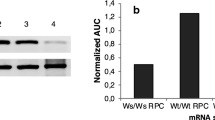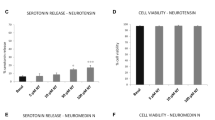Abstract
It has been reported that the loop diuretic frusemide can prevent exercise induced asthma, and that this effect may be due to the inhibition of mast cells in the airway. By using various mast cell secretagogues which increase intracellular calcium via different routes, this study attempted to elucidate the mechanism of the mast cell stabilizing action of frusemide. As well as confirming that immunologically induced histamine release from rat peritoneal mast cells was dose dependently inhibited by frusemide (10−3–10−5 M), the present study has extended the observation to histamine release induced by compound 48/80. The inhibitory potency was however less in the case of compound 48/80 induced release. Frusemide induced inhibition by the two secretagogues was decreased by drug preincubation. In contrast, histamine release induced by ionophore A23187 and thapsigargin was not inhibited by frusemide. The prototype antiallergic compound disodium cromoglycate (DSCG) demonstrated a similar specificity pattern against the various secretagogues. Another loop diuretic, bumetanide, did not show the same results as frusemide on rat peritoneal mast cell degranulation. Hence it is concluded that frusemide does not inhibit immunological activation of mast cells via its diuretic Na+/K+/Cl− co-transporter capacity. Instead, it protects mast cells in a similar manner to DSCG.
Similar content being viewed by others
References
Widdicombe JW, Nathanson IT, Highland E. Effects of “loop” diuretics on ion transport by dog tracheal epithelium. Am J Physiol 1983;245:C388–96.
Robuschi M, Vaghi A, Gambaro G, Spagnotto S, Bianco S. Inhaled furosemide (F) is effective in preventing ultrasonically nebulized 5.8% NaCl bronchoconstriction. Eur Respir J 1988;1 Suppl 2:193s.
Bianco S, Vaghi A, Robuschi M, Pasargiklian M. Prevention of exercise-induced bronchoconstriction by inhaled frusemide. Lancet 1988;2:252–5.
Robuschi M, Gambaro G, Spagnotto S, Vaghi A, Bianco S. Inhaled furosemide (F) is highly effective in preventing ultrasonically nebulized water(UNH2O) bronchoconstriction. Pulm Pharmacol 1989;1:187–91.
Bianco S, Pieroni MG, Refini RM, Rottoli L, Sestini P. Protective effect of inhaled furosemide on allergen-induced early and late asthmatic reactions. New Engl J Med 1989;321:1069–73.
O'Connor BJ, Chung KF, Chen-Worsdell YM, Fuller RW, Barnes PJ. Effect of inhaled furosemide and bumetanide on adenosine 5′-monophosphate- and sodium metabisulfite-induced bronchoconstriction in asthmatic subjects. Am Rev Respir Dis 1991;143:1329–33.
Redrup AC, Pearce FL: Effect of loop diuretics on rat peritoneal and human lung mast cells. Agents Actions 1994;41:C47–8.
Bazin H, Pauwels P. IgE and IgGa isotypes in the rat. Prog Allergy 1982;32:52–104.
Mackay GA, Pearce FL. A comparison of rat peritoneal mast cells purified using Percoll and Path-O-Cyte 4. Agents Actions 1992;C315–7.
Alfonso A, Botana MA, Vieytes MR, Louzao MC, Botana LM. Effect of signal transduction pathways on the action of thapsigargin on rat mast cells. Biochem Pharmacol 1994;47:1813–20.
Atkinson G, Ennis M, Pearce FL. The effect of alkaline earth cations on the release of histamine from rat peritoneal mast cells treated with compounds 48/80 and peptide 401. Br J Pharmacol 1979;65:395–402.
Foreman JC, Mongar JL, Gomperts BD. Calcium ionophores and movement of calcium ions following the physiological stimulus to a secretory process. Nature 1973;245:249–51.
Berridge MJ, Irvine RF. Inositol phosphates and cell signalling. Nature 1989;341:197–205.
Dar O, Pecht I. Fec receptor mediated Ca2+ influx into mast cells is modulated by the concentration of cytosolic free Ca2+ ions. FEBS Lett 1992;310:123–8.
Tasaka K, Mio M, Okamoto M. Intracellular calcium release induced by histamine releasers and its inhibition by some antiallergic drugs. Ann Allergy 1986;56:464–9.
Kuno M, Kawaguchi J, Mukai M, Nakamura F. PT pretreatment inhibits 48/80-induced activation of Ca2+-permeable channels in rat peritoneal mast cells. Am J Physiol 1990;259:C715–22
Hide M, Beaven MA. Calcium influx in a rat mast cell (RBL-2H3) line. J Biol Chem 1991;266:15221–9.
Penner R, Matthews G, Neher E. Regulation of calcium influx by second messengers in rat mast cells. Nature 1988;334:499–504.
Matthews G, Neher E, Penner R. Second messenger-activated calcium influx in rat peritoneal mast cells. J Physiol 1989;418:105–30.
Putney JW Jr. A model for receptor regulated calcium entry. Cell Calcium 1986;7:1–12.
Felder CC, Singer-Lahat D, Methes C. Voltage-independent calcium channels. Biochem Pharmacol 1994;48:1997–2004.
Thatsrup O, Dawson AP, Scharff O, Foder B, Cullen PJ, Drøbak BK, et al. Thapsigargin, a novel molecular probe for studying intracellular calcium release and storage. Agents Actions 1989;27:17–23.
Pearce FL, Al-Laith M, Bosman L, Brostoff J, Cunniffe T, Flint KC, et al. Effects of sodium cromoglycate and nedocromil sodium on histamine secretion from mast cells from various locations. Drugs 1989;37 Suppl 1:37–43.
Mazurek N, Berger G, Pecht I. A binding site on mast cells and basophils for the anti-allergic drug cromolyn. Nature 1980;286:722–3.
Martin MW, O'Sullivan AJ, Gomperts BD. Inhibition by cromoglycate and some flavanoids of nucleoside diphosphate kinase and of exocytosis from permeabilized mast cells. Br J Pharmacol 115:1080–6.
Wells E, Mann J. Phosphorylation of a mast cell protein in response to treatment with anti-allergic compounds. Biochem Pharmacol 1983;32:837–42.
Lucas AM, Shuster S. Cromolyn inhibition of protein kinase C activity. Biochem Pharmacol 1987;36:562–5.
Author information
Authors and Affiliations
Additional information
accepted by W. Lorenz
Rights and permissions
About this article
Cite this article
Stenton, G.R., Lau, H.Y.A. Inhibition of rat peritoneal mast cell exocytosis by frusemide: A study with different secretagogues. Inflamm Res 45, 508–512 (1996). https://doi.org/10.1007/BF02311087
Received:
Revised:
Accepted:
Published:
Issue Date:
DOI: https://doi.org/10.1007/BF02311087




